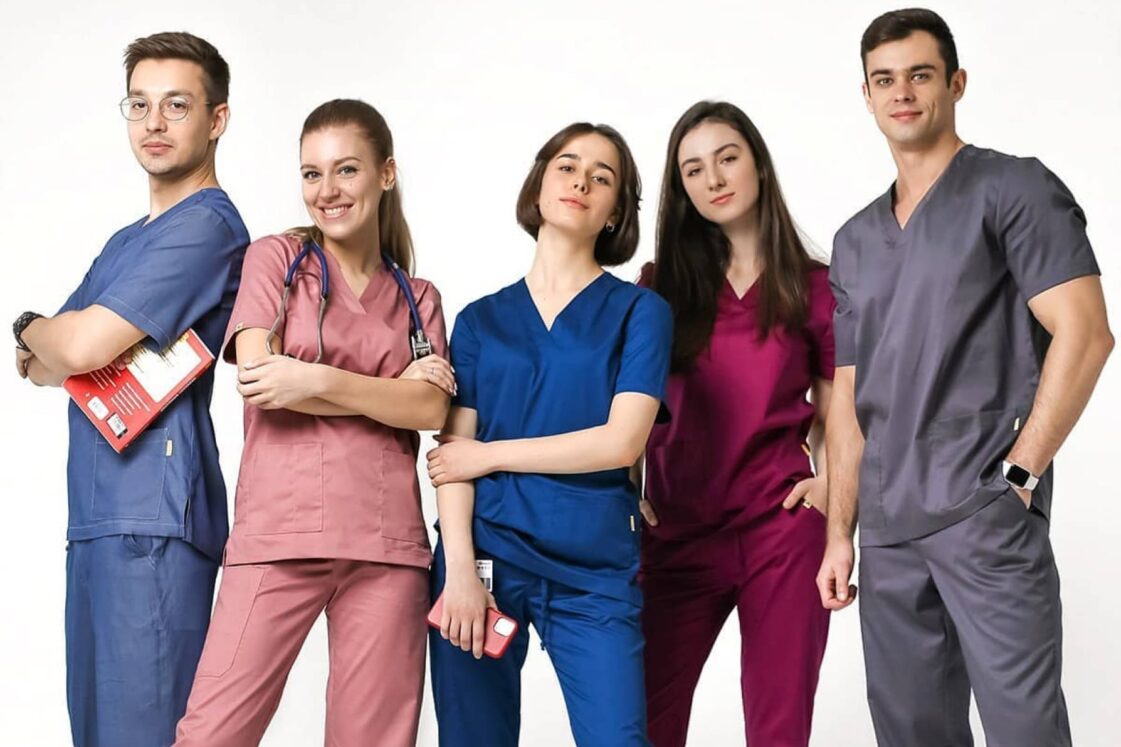Medical clothing is traditionally associated with practicality and simplicity, but modern trends dictate new standards. Today, more and more healthcare workers want their uniforms to be not only comfortable, but also stylish. How can design transform medical workwear and make it more aesthetically pleasing and functional? Let’s figure it out.
- Unique designs
One of the key aspects that design studios can bring to medical clothing is unique and contemporary designs. Using original prints, interesting color combinations and innovative styles, you can create clothes that will stand out from the traditional uniform. Elements such as asymmetrical lines, unusual pockets and modern materials give medical clothing a stylish look.
- Functionality and comfort
However, the design does not have to be purely decorative. Functionality and comfort remain top priority. Designers work to ensure that clothing is comfortable for long-term wear, provides freedom of movement and ventilation. The use of modern fabrics that “breathe”, wick away moisture and have antibacterial properties significantly increases the level of comfort.
- Customization
An individual approach to the design of medical clothing is becoming increasingly popular. The ability to customize allows healthcare providers to add their own logos and also allows each employee to feel unique. Name patches, color accents and other custom touches help create a sense of belonging and unity within the team.
- Modern materials
The use of modern materials is an important aspect in the creation of medical clothing. Fabrics that are easy to wash, dry quickly and do not lose color make uniform care much easier. Materials such as microfiber, spandex and new types of cotton make clothing more durable and comfortable.
- Joint projects and collaborations
Design studios often collaborate with medical institutions and famous designers to create exclusive collections. Such collaborations attract attention and increase the prestige of the brand. These collections typically combine high quality, functionality and style, making them especially attractive to healthcare professionals.
- Marketing and promotion
To successfully promote designer medical clothing, it is important to use effective marketing strategies. Social networks, blogs and advertising campaigns help convey the uniqueness and benefits of your products to a wide audience. Creating visual content that shows what a garment looks like in real life helps potential buyers see it in action.
- Reviews and examples of use
Feedback from healthcare professionals who already wear designer uniforms is a valuable promotional tool. Real stories and examples of use help build trust in the brand and show that the clothes are not only beautiful, but also comfortable in everyday work.

Beauty and practicality:
Today’s healthcare professionals spend long hours on their feet while dealing with the many challenges of their profession. In such conditions, the comfort and functionality of clothing become critical. However, the pursuit of convenience should not exclude aesthetics. In recent years, design studios have been offering unique solutions that make medical uniforms not only practical, but also stylish.
- Innovative materials
The basis of any functional medical clothing is the materials from which it is made. Modern fabrics such as premium cotton, microfiber and spandex provide comfort and durability. These materials allow the skin to breathe, wick away moisture and dry quickly, which is especially important in intensive work conditions. The antibacterial and hypoallergenic properties of the fabrics provide additional protection for healthcare workers and their patients.
- Ergonomic design
The design of medical clothing must take into account the specifics of the work of doctors. Convenient tool pockets, reinforced seams and durable fasteners are all important elements that make the uniform functional. However, ergonomics can be combined with aesthetics. A range of stylish details, such as contrasting inserts, decorative seams and unusual cutouts, create designs that look modern and attractive.
- Individualization and customization
One of the biggest trends in medical clothing design is the ability to customize. Personalized elements such as name patches, hospital logos and custom colorways help create a sense of belonging and team spirit. Personalization also allows healthcare workers to express their personality and style, which is especially important in a standard uniform setting.
- Joint collections and collaborations
To increase the prestige and recognition of the brand, design studios often collaborate with famous designers and medical institutions. Such collaborations allow you to create unique collections that combine the best features of functionality and aesthetics. This can be especially attractive to healthcare organizations looking to differentiate themselves from competitors and offer something special to their employees.
- Marketing Strategies
Successful promotion of designer medical clothing requires an integrated approach to marketing. It is important to use social media, blogs, video content and other channels to demonstrate the benefits of your products. Real stories and testimonials from healthcare professionals who already wear designer uniforms will help build trust and attract new clients.
Aesthetics and comfort in scrubs uniform
Modern scrubs uniforms are significantly different from traditional medical uniforms due to the introduction of innovative design solutions. These updated models not only provide maximum comfort and functionality for healthcare workers, but also look stylish and modern. The use of advanced materials, such as breathable fabrics with antibacterial properties, and attention to detail in design make scrubs uniform an integral part of the daily work of healthcare professionals, helping them to feel confident and professional in any environment.
Conclusion:
Designer medical clothing strikes a balance between aesthetics and functionality, helping healthcare workers feel comfortable and confident. The use of modern materials, ergonomic design and customization options make such clothes not only comfortable, but also stylish. Collaborative projects and effective marketing strategies help differentiate a brand and attract the attention of a wide audience. Ultimately, designer medical clothing contributes to a more pleasant and productive work environment, which has a positive impact on the quality of healthcare services.
